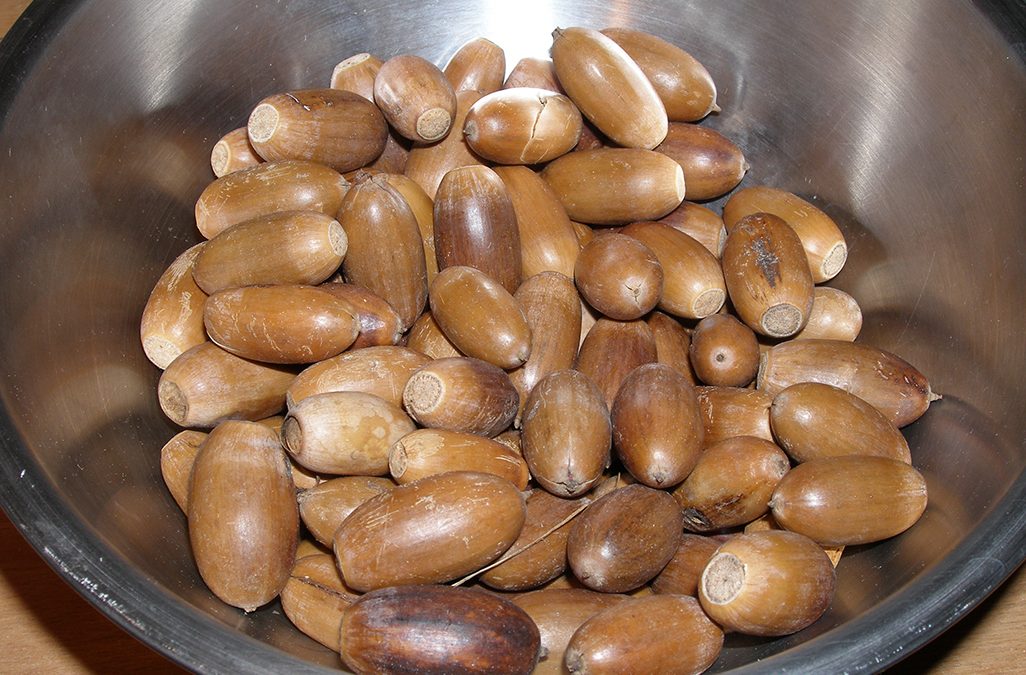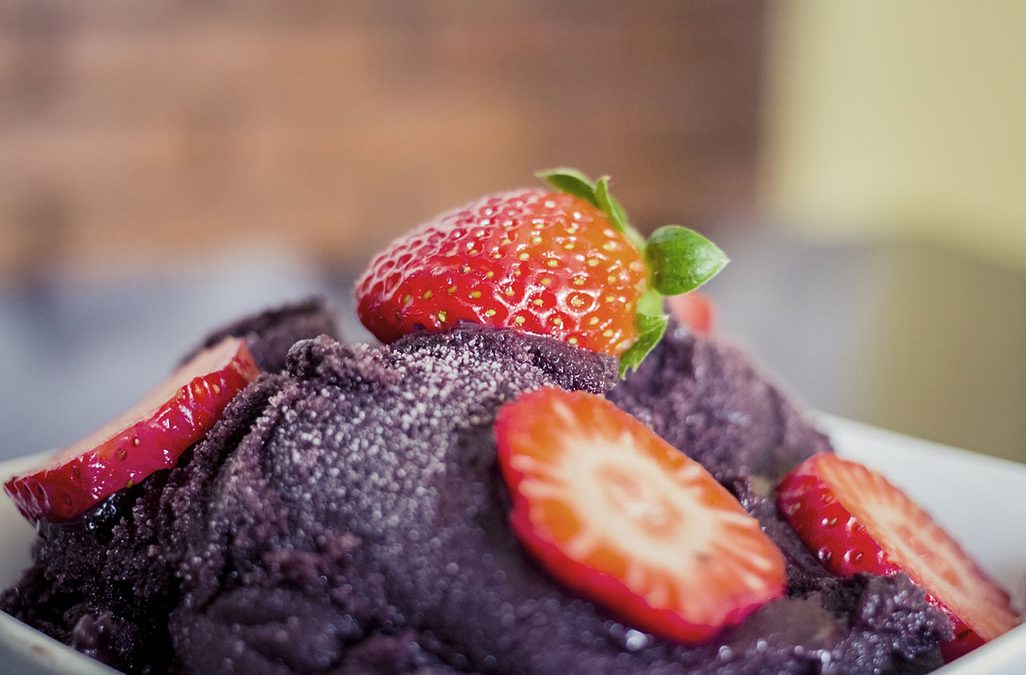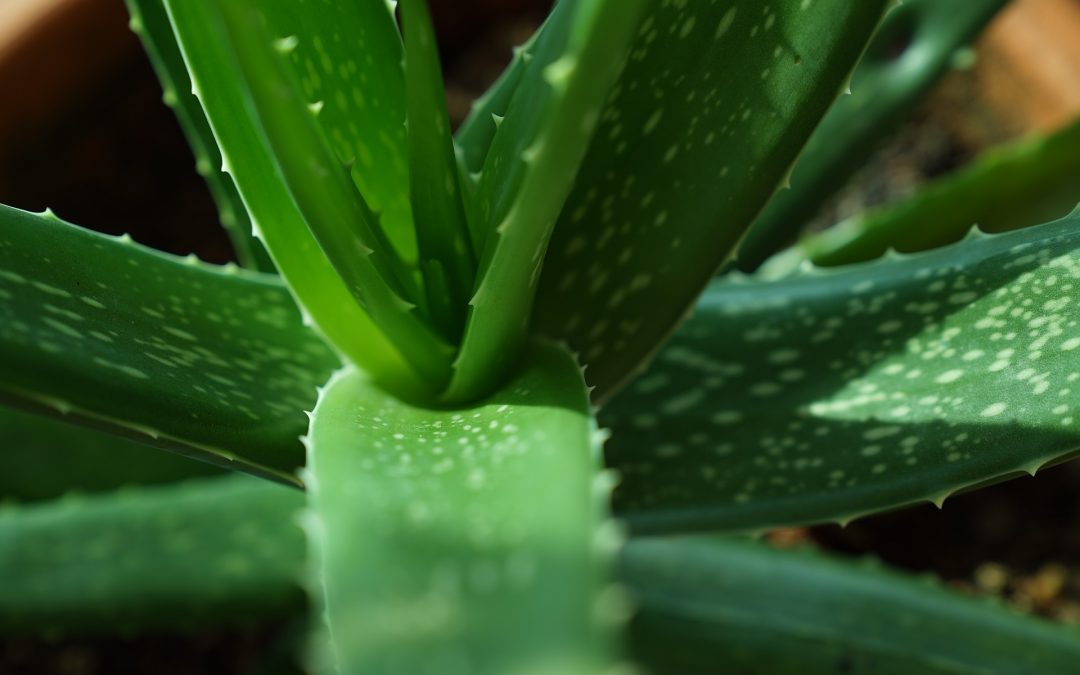
Aloe (Aloe vera)
Although originating in the hot and arid climes of northern Africa, to most of us Aloe Vera is no longer an exotic stranger. Not only do we see it advertised as a popular ingredient in a multitude of household products, ranging from washing-up liquid to latex gloves, and even razors, but many of us are familiar with the plant itself. Aloe Vera is a perennial succulent, undemanding and not particularly eye-catching. It vaguely resembles a small version of the century plant, so common in the North American Southwest. However, despite the superficial similarities, Aloe is an entirely different species of plant. Like the century plant, it belongs to the order of Asparagales but it does not share the same genus. Formerly broadly ascribed to the Lily family, taxonomists have now reassigned it to the genus of Asphodelaceae.
The fleshy, succulent leaves contain a clear, gooey gel. The leaf margins bear ‘sharp teeth’ that act quite effectively as a deterrent against casually browsing animals. Aloe loves hot and dry conditions and appears to wilt only if it receives excessive amounts of water, or if exposed to freezing temperatures. If grown in the right conditions, that is, mostly ignored, the plant will do fine. If it is really happy with its care and location, it may even send up a central shoot once a year, sporting short, tubular, yellowish flowers around the upper part of the spike.
There are about 400 species in the Aloe genus, but for medicinal purposes, Aloe Vera is the most useful. Mature plants of about 4-5 years are preferred as they provide the most potent healing compounds.
Ecology:
Aloe Vera is native to arid regions of north-eastern and southern parts of Africa and Madagascar. Thanks to its tremendous value as a healing plant, it has quickly spread to arid regions throughout the world. Today it is widely cultivated in similar environments pan-globally, including Mexico, USA, Japan, and China.
History
As is often the case with so-called ‘miracle plants’, their exaggerated reputation actually discredits them. Aloe Vera is a truly wonderful plant with no shortage of members to its fan club. It has a very ancient, well-established reputation as a medicinal plant, particularly useful for skin conditions, minor cuts, abrasions, and burns. The dried latex, which is not the same as the gel, but instead derives from the yellow juice contained in the pericyclic tubules of the inner leaf, is a well-known laxative.
Despite the fact that Aloe has been in documented use for at least 3500 years, controversial and contradictory information abounds. The earliest mention can be found in the famous Egyptian Ebers Papyrus, which dates back to 1500 BC and which is widely regarded as one of the earliest precursors of what was to become the western Materia Medica. However, it is more than likely that it was commonly used for centuries before it was recorded. In fact, it seems more likely that Aloe was such a commonly used plant that earlier documents (of which few have survived) never even bothered to mention it. In the hot and dry countries of the Mediterranean and the Middle East, Aloe Vera served as a soothing household remedy for sunburns and a ready-to-use moisturizing cosmetic lotion.
Some of the confusions surrounding this plant stem from the fact that it is frequently mistaken for lignum Aloes or Wood-Aloes, which is an entirely different species of plant. Although abundantly mentioned in the Bible as an incense ingredient and constituent of embalming oils, Wood-Aloes, in fact, is not even of Mediterranean origin. In fact, it is a tree belonging to the genus Aquilaria, known as Agarwood that is native to Southeast Asia. While the latex of Aloe Vera does dry and transforms into a hard substance, sometimes referred to as Aloe resin, it is not a particularly aromatic substance and has never been used as incense.
As mentioned above, Aloe Vera’s best known and most widely documented use is as an external application – usually in the form of a commercially produced gel. Such products do not offer quite the same benefits as the fresh gel obtained from a freshly cut leaf. The reason for this is simple. The natural jelly-like substance is not very stable and deteriorates quickly when exposed to air (oxidation). Commercial manufacturers have to process the gel in order to preserve the valuable properties and extend the shelf-life. But processing rarely enhances a natural product. More often it reduces a ‘miracle herb’ to a mediocre substance with questionable benefits. By the time it has been rendered into a substance that is suitable for use as an ingredient for creams and lotions, the remaining benefit will be minimal.
And this sheds some light on some of the rather puzzling research results: although Aloe Vera has a glowing reputation in folk usage, when tested in laboratories the results have often been fairly disappointing. Why would that be? The answer seems to lie not so much with the plant, in the laboratory conditions and processing methods. Lab conditions do not simulate traditional, real-life use very well. Instead, keen to discover and exploit a plants’ ‘active principles’, extracts are concocted that are supposed to concentrate the potency – but invariably destroy the plants’ natural synergy. Also, when the actual gel was used instead of extracted components, the quality was questionable. Conventional methods to stabilize and preserve the gel involve pasteurizing, which means the gel is heated to a high temperature, thus destroying many of the more sensitive constituents. Furthermore, preservatives are added, which further adulterate the gel. So, while many research results seem to demonstrate that much of Aloe’s benefits may be hype, what they actually show is that we lack proper processing methods to preserve the natural composition of fresh Aloe Vera gel.
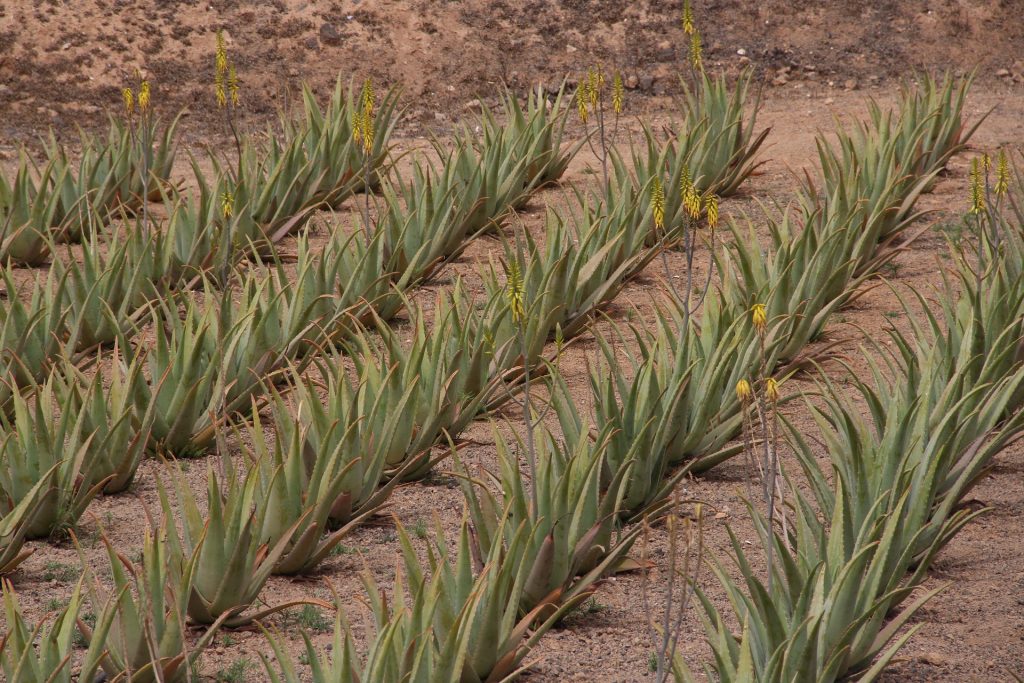
A recent trend has popularised ‘Aloe vera juice’ (as well as a myriad spin-off products that contain the juice). This product is always processed and often mixed with sundry flavourings of dubious origin to make it more palatable and to extend its shelf-life. In its natural form, Aloe juice (gel) is rather bitter and not exactly a pleasure to gulp down, which is probably why there is no mention of this particular use in any of the traditional medical texts, except perhaps as an emergency measure or ‘heroic’ medicine to treat intestinal parasites or gastric infections.
Due to enzymatic processes oxidation sets in as soon as the leaves are cut. Careful handling during the harvesting process is of utmost importance. Once cut, the leaves are taken to a processing facility as quickly as possible, ideally in a refrigerated truck. At the processing plant, the leaves are filleted by hand to remove the outer, green skin. Unfortunately, most of the beneficial compounds are concentrated just beneath that outer skin and filleting removes many of these compounds and discards them along with the skin.
Recently, more efficient processing methods have been developed, which utilise the whole leaf and by removing only the green parts of the leaf in a cold process that involves a cellulose dissolving substance. This maintains the biochemical activity in its entirety. The resulting gel is yellow in colour, as it also retains the aloin, the bitter, laxative compound found just beneath the surface. Further processing involves adding various anti-oxidants since any oxygen present in the gel promotes breakdown and deterioration, as well as providing a breeding ground for aerobic bacteria. Finally, the pulp is separated from the liquid part, the aloin is filtered out by adding a carbon compound that is subsequently removed. To destroy any bacteria the liquid is then passed through tubes and exposed to ultraviolet light.
This method still requires stabilising compounds to be added to the final product, but it is a great improvement over conventional processing techniques that only processed the gel and applied a heat treatment to sterilize the liquid.
Another whole-leaf extraction method involves the same cold process leaf processing as the first step, but then uses a short, low temperature controlled sterilisation techniques to kill off bacteria, without adding chemicals. The resulting gel is then concentrated in a vacuum chamber and dehydrated to yield a water-soluble compound that retains the biochemical activity, without the need for additional preservatives. This method is currently regarded as the most efficient, even though heat is used in the process. The heating is closely controlled and never exceeds 65°C or lasts for more than 15 minutes at a time. Longer exposure or higher temperatures would degrade the final product.
Thus, it should be obvious that what is available at the store is not the same as what you get from the plant and that it is important to read the label so as to gain insight into the specific processing procedures that have been applied to the product.
Producers have established a self-regulating body to certify Aloe Vera products according to their own standards of quality control. Their seal of approval gives a certain degree of reassurance that the products do contain what the labels claim. However, there are even differences between certified companies, which are largely due to different methods of processing.
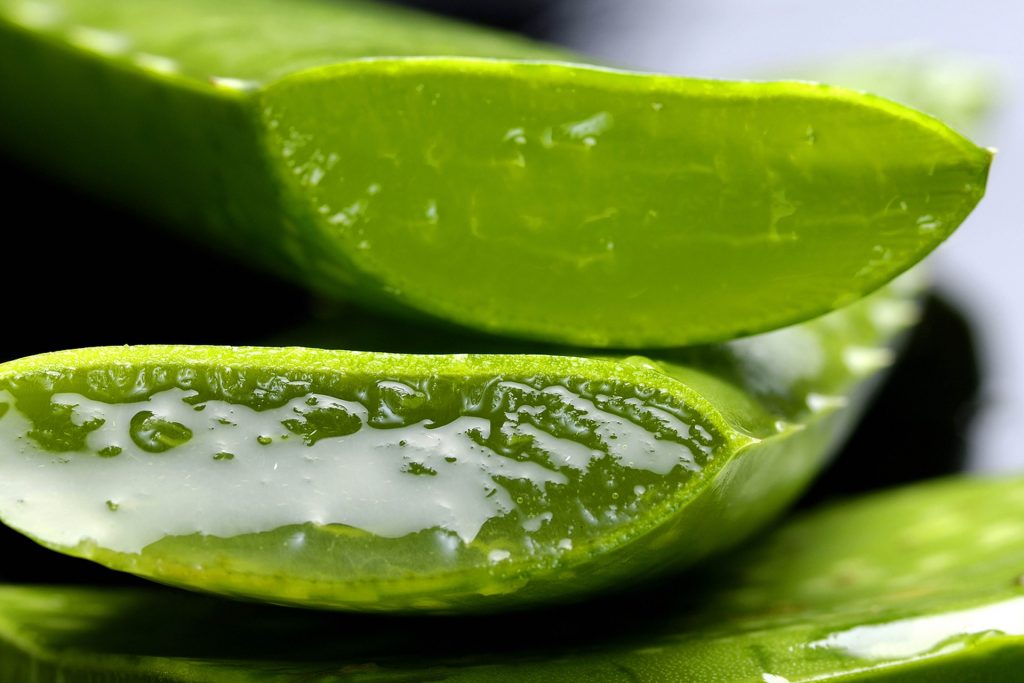
Medicinal Uses
Parts used: resin, gel extracted from the leaf
Constituents: Hydroxyanthracene derivatives of the anthrone type (principally barbaloin); 7-
Actions: latex: cathartic, laxative, emmenagogue, digestive stimulant
Gel: immune system stimulant, skin healing, anti-irritant, moisturizing, anti-cancer
Indications
Traditionally, Aloe Vera gel has been used as a soothing topical application for sunburns and minor burns, abrasions, acne, psoriasis, shingles and even cold sores. The gel can be squeezed from the fresh leaf and applied directly to affected areas. Its skin repair qualities on burns and sunburns are truly remarkable – healing occurs quickly and without scarring, which is why Aloe Vera is also used to reduce scarring and stretch marks. The gel even seems to protect the skin against immune suppressant effect of ultraviolet light – thus it not only makes an excellent ‘after sun care’ application but may also be useful as a protective sunscreen lotion. It is a highly valued additive for cosmetic preparations that can moisturize and rejuvenate the skin by stimulating the synthesis of elastin and collagen.
External application of Aloe gel penetrates the skin directly and produces a soothing, pain-relieving and anti-inflammatory effect on arthritic joints and tendonitis.
For internal use, Aloe Vera latex preparations are usually mixed with antispasmodic herbs to reduce the spasmodic effect of its laxative action. Used by itself it would produce a rather cathartic and painful cramping effect. The latex also stimulates the uterus thus promoting menstrual flow. Laxatives containing Aloe latex should be avoided during pregnancy.
Used internally, high-quality Aloe vera juice can stimulate the immune system. Laboratory studies on mice have shown it to be effective in the treatment of certain types of cancer and HIV and further studies are on the way.
Aloe juice seems to have a healing and balancing effect on the digestive system, improving absorption of nutrients and eliminating toxins. This improves general cell nutrition and activates the body’s own healing powers. It can relieve gastrointestinal problems associated with peptic or duodenal ulcers, improve regularity and enhance energy levels. It is also used to soothe colitis and irritable bowel syndrome. In fact, many chronic conditions have a component of digestive imbalance, which is apt to trigger secondary symptoms due to malabsorption and cellular malnutrition. Aloe vera juice can help to restore balance to the entire digestive system.
Furthermore, Aloe Vera juice also appears to have a beneficial effect on the liver and kidneys. It seems to reduce levels of blood lipids that are liable to clog up the arteries and may lead to coronary heart disease. It also seems to have a positive effect on blood sugar levels, which can make it a useful nutritional supplement in case of diabetes.
Caution:
Do not use Aloe Vera based laxatives during pregnancy. The juice may also be adulterated or contain levels of aloin above what would be deemed safe during pregnancy.
If you are on prescription medication consult with your health advisor regarding possible interference with other medicines when using Aloe Vera internally.
The quality of Aloe Vera gel or juice very much depends on the manufacturing process and some products that are currently on the market have little or no medicinal value. Research the products carefully before spending a lot of money on what may turn out to be an inert substance. Whole-leaf extracts are recommended. Look for the International Aloe Science Council certificate for quality assurance.
Grow your own
Everybody should have an Aloe Vera plant on their kitchen window sill. It is without a doubt the best instant remedy for burns. Growing Aloe Vera is easy, as it is a very undemanding plant. Just don’t over-water it and protect it against freezing temperatures. It loves the sun but will grow in semi-shade as well. It does not need particularly rich soil. Well-draining, sandy soil will do.
Home-made cosmetics
If you wish to incorporate Aloe vera gel in your own home-made skin-care products, you can use the gel to replace all or a portion of the liquid called for in your recipe. However, beware that unprocessed Aloe Vera gel is not very stable and won’t keep long, so make small batches only, store in the fridge and use up quickly. For maximum benefit, skin care preparations should contain at least 20-40% of gel. Purists may opt to simply cut a bit of leaf off and to rub it straight onto the skin.

